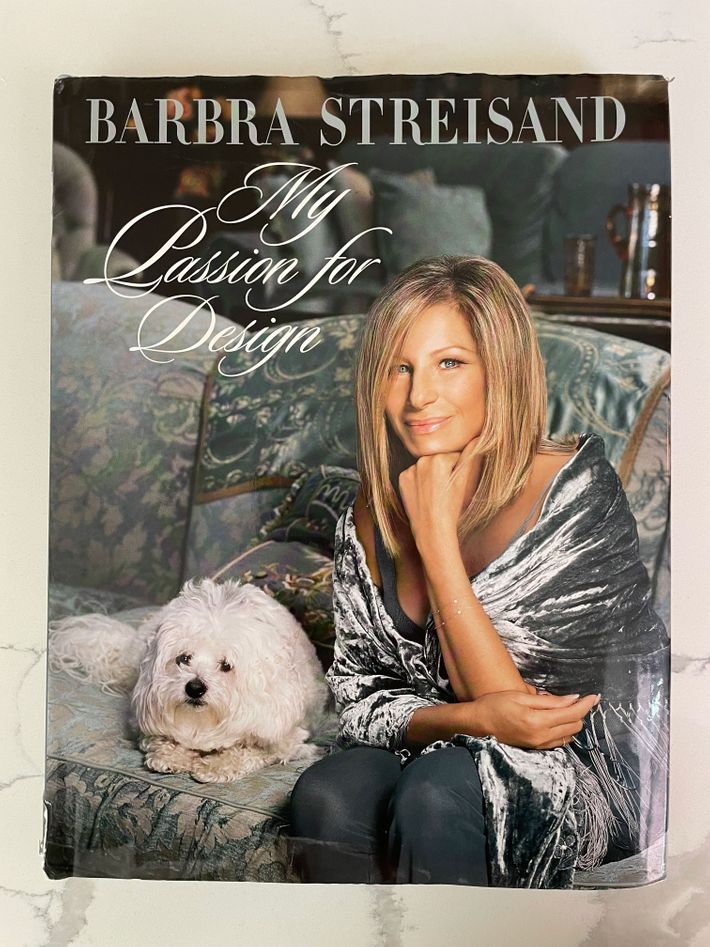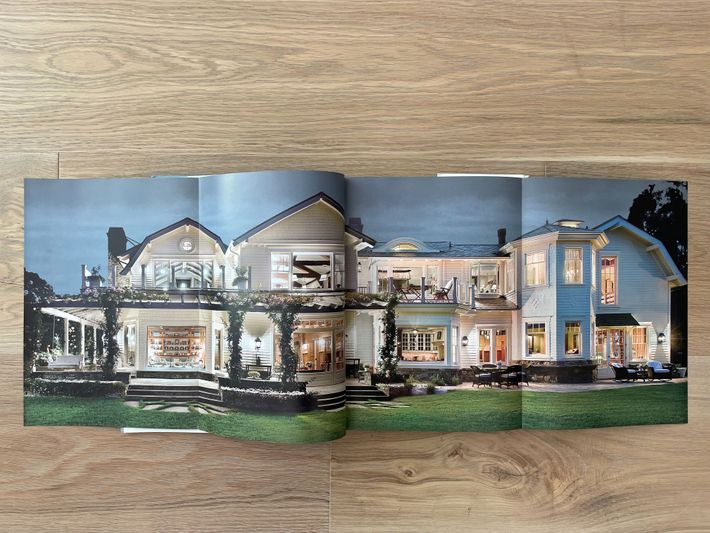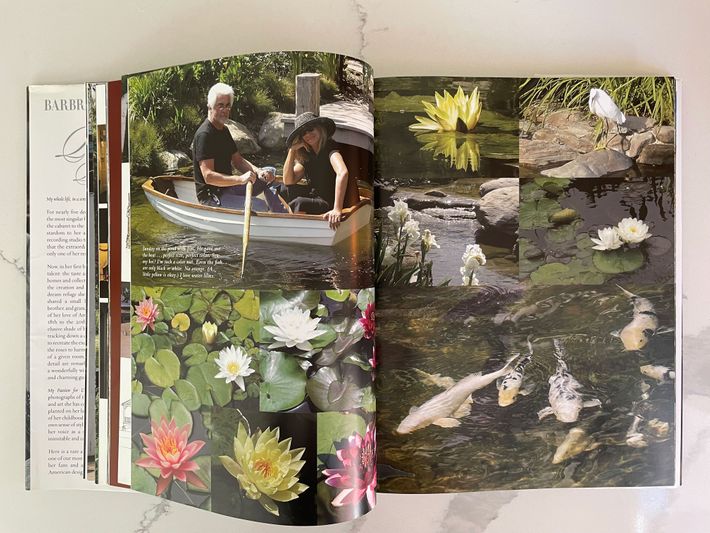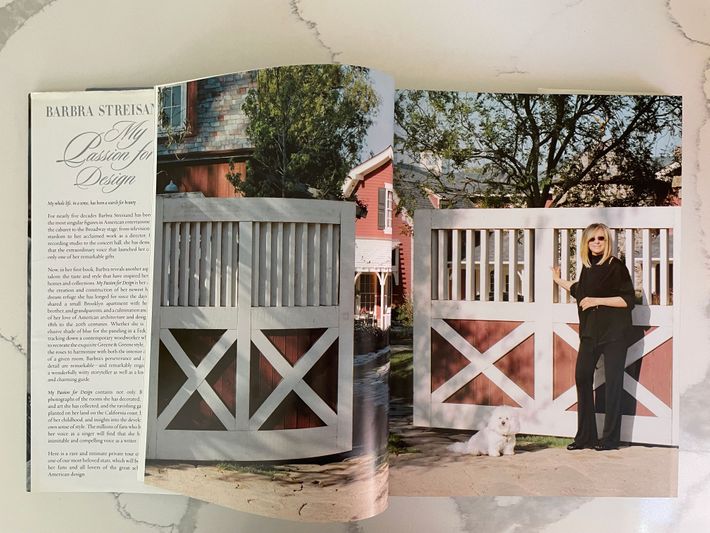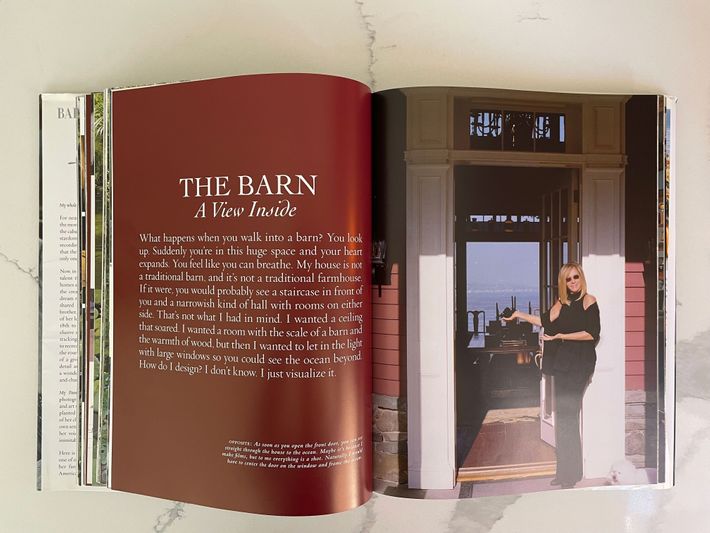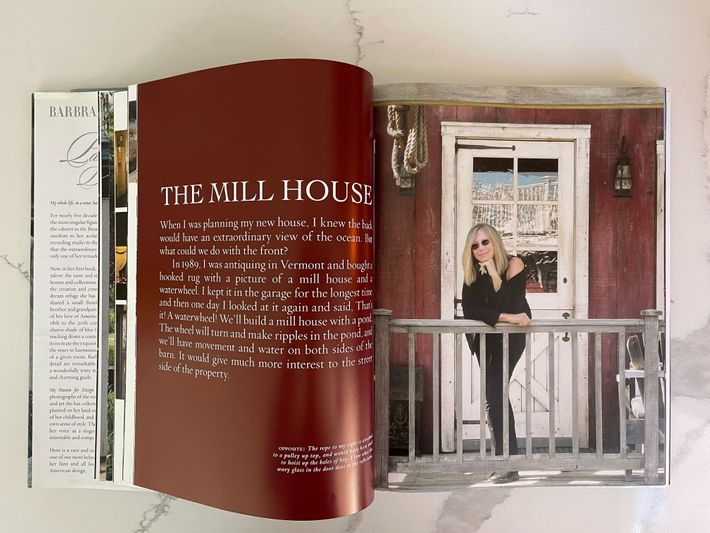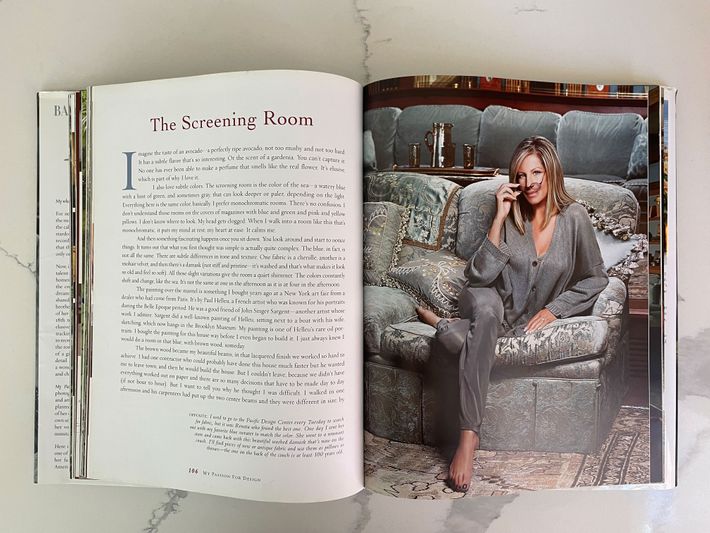Barbra Streisand’s My Passion for Design: Review
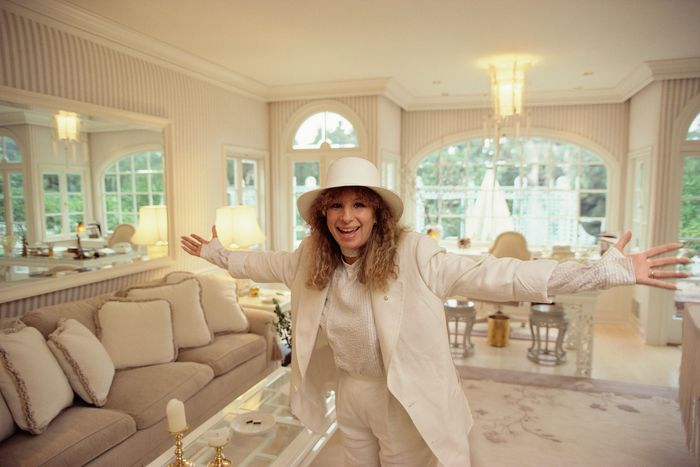
Photo: Douglas Kirkland/Corbis via Getty Images
Barbra Streisand is supernaturally good at almost everything: singing, acting, writing, directing, cloning. She is chutzpah in human form, an iconoclast who has looked both Nick Nolte and death in the face and said, “Feh!” She is so hard-core that she once made Larry McMurtry vomit out his car window after a friendly game of tennis.
In other words, it’s nearly impossible to capture Barbra Streisand’s essence, because she has hundreds of essences, all of them awe-inspiring in the Old Testament sense. So it’s inevitable that, in the flurry of tributes surrounding her recent 80th birthday, bits and pieces of her expansive brilliance have been left out. Which is why I am here to revisit one of the most important works of art that Barbra Streisand has ever put forth, a creation that, in my opinion, we should all be revisiting on a weekly basis as a guide to living Barbra-ly: My Passion for Design, her mammoth, madcap, 300-page (including an epilogue) coffee-table book on the construction and design of her sprawling compound in Malibu.
Photo: Rachel Handler
Published in 2010 but emanating a distinctly ’90s energy, My Passion for Design is an exercise in Streisand-ish goofiness and grandeur, unapologetic excess, and near-nuclear attention to detail. The title refers, of course, to Barbra’s account of creating her home’s design — her self-proclaimed “intense relationships with furniture” and the meticulous construction of her main home and its detached barn, millhouse, and “Grandma’s house” — but it is just as fascinating to read the book as Barbra’s account of her brain’s design. (“When I step into an 18th-century room, something about it feels so satisfying to me”; “French automatons fascinate me …”) To reduce it to a mere vanity project misses the point; it is also a project investigating the point of vanity.
My Passion for Design is about a Jewess building a paean to goyish Americana (complete with a “Federal Lounge,” a 4,000-pound waterwheel, and a fictional backstory about postcolonial settlers) in a conscious effort to distance herself from the plastic-sheathed couches of her mother’s Pulaski Street apartment. It is a rags-to-riches fable that begins with Barbra eating chicken soup on the streets of New York while hunting for knockoff antiques and ends with her eating spelt pancakes on the California coast, trading stocks from her custom-size bed (king is too big, queen is too small) to support her Tiffany-lamp habit. It juxtaposes philosophical ruminations on loss with sentences like “I’ve always loved barns.” It is about the uniquely American optimism that if you never stop buying things, you can cheat death.
And while we await her alleged future memoir, it may be the most significant attempt at a distillation of Barbra, a true manifesto written in her sublime voice, which is a conversational stream of consciousness, lousy with randomly placed ellipses and anecdotes about her dozens of dismissed architects and Steven Spielberg’s use of GPS. “Sometimes I’m impatient … too impatient to wait until I find the right thing,” she writes while lamenting her perfectionism. “So I’ll just get something in the meantime because my need for instant gratification is strong. Perhaps that’s because my father died so young.”
Photo: Rachel Handler
I recently plucked My Passion for Design from the coffee table at my friend’s aunt’s Seder on the Upper East Side and paged through it while eating gefilte fish and horseradish. I was familiar with it as the spark of inspiration for Jonathan Tolins’s 2013 play about Streisand’s basement mall, Buyer & Cellar, but I was not familiar with it on a line-by-line level, which is how it demands to be consumed. Though I recommend you set aside a day to luxuriate inside each and every one of the book’s stories and Barbra-shot photos, I have attempted to crystallize the experience of reading My Passion for Design by selecting 30 of the book’s Most Barbra Moments. Taken on their own, each quote — the ellipses and italics always hers, unless otherwise specified — offers a bit of singular Barbra wisdom that you may want to consider applying to your own life and Malibu barn.
1. On Oil-Drilling Robots: [Ed. note: This is My Passion for Design’s literal second sentence.] “In this frenetic world we live in, it seems as if machines are taking over … computers that drop the stock market a thousand points in a matter of minutes, metal detectors, oil-drilling robots. I don’t pretend to know much but I do think that technology without consciousness invites disaster.”
2. On Color Theory: “I used to have long discussions with my gardener, when we were choosing flowers, about what is red and what is pink. You can’t just say something is red.”
3. On Vocals: “My voice was hoarse from shouting over buzz saws for years.”
4. On Mistakes: “Here’s an example of a mistake! I’m sure someone was trying to please me when he changed the drawing and fancied up the panel by the window seat. But it didn’t look right. The lines of the raised panel should just die into the side of the window seat, as you see in the finished version.”
Photo: Rachel Handler
5. On Perfect Logic: “And then an idea occurred to me. I had some leftover fabric so I designed a dress to match the loveseat. Why shouldn’t you wear clothes to match the room? It seemed perfectly logical to me.”
6. On Human Contradiction: “I don’t like feeling a sense of loss … even something I’ve lost at an auction can haunt me. Years ago, a rare pin by the Viennese architect Josef Hoffmann was coming up for sale, and I left a bid because I couldn’t attend. I lost it to the next bidder. (This is why I don’t like to leave bids. You have to at least be on the phone.) I was so upset, and then of course I wanted it even more. My dear Renata Buser, who has been my personal assistant for more than 35 years, tried to have the pin copied for me but it wasn’t the real thing. I wouldn’t give up until I had traced that pin halfway around the globe, to a dealer in Germany. I ended up paying him four times what it went for at auction … and then never wore it.”
7. On America: “Then in 1992 when Bill Clinton was elected president, I fell in love with America all over again. [several sentences pass] At the Library of Congress, when they asked if I wanted to look at my own things, I said no. I just wanted to see Thomas Jefferson’s drawings of the dome at Monticello.”
8. On Intuition: “Let me say this: It was not an easy project. It was a creative challenge to blend several styles from several centuries. Some architects told me to not even try. But that was my dream, my vision … very similar to making a film. As an actress, I have always relied on my intuition. Same thing here … I’m happy with the results … even though I don’t live in it.”
Photo: Rachel Handler
9. On Indecision: “I’ve always wanted chickens. Shouldn’t a barn have animals? I wish we had room for cows … pigs … I love pigs. (I’ve been collecting miniature figurines of them for years.) But the most I’ve been able to manage is chickens. We have 22 of them and one rooster. At one point I decided to give him away because he does that crow thing all day long and I thought the neighbors would complain. But the next day I missed him, so I had him picked up and brought back.”
10. On Patience: “The design process seemed to go soooooo slowly. The first architect would appear for a meeting and then come back three weeks later having forgotten the changes he was supposed to have made. After that experience, I had another architect move in with me for five days a week so I could keep an eye on what he was drawing. (He lived too far away to commute.)”
11. On Wood: “While I was doing an interview with Diane Sawyer and telling her I was going to build a barn, she mentioned that her husband, Mike Nichols, knew the old-wood expert and she would get me his name. I told her to send it along with her recipe for cornbread.”
12. On What Happens When You Change Things Without Asking Her: “What was kind of shocking is that even with all of the measurements, it could still go wrong … sometimes because somebody decided to change things without asking me.”
13. On That Palace: “In Vienna I saw the most beautiful herringbone floor in one of the palaces. I measured the width of the boards and sent pictures back to my crew, telling them that this was how I wanted the floor to look in this room. What palace was that? It’s famous. I sang in front of it. Oh God, this is terrible. And it’s not age. I never know where I am. I’ve lived in London several times but I couldn’t tell you where unless I looked it up. Years ago, Steven Spielberg and I would get lost trying to find a street in Beverly Hills, where we lived! No kidding.” [One paragraph and several anecdotes later] “The Schönbrunn Palace! That’s it.”
Photo: Rachel Handler
14. On Hubris: “Let me just say this now: It is by no means easy to build a pond.”
15. On the Word No: “I wanted a storm cellar, like in The Wizard of Oz. It’s not that I’m expecting a tornado, but with climate change, you never know! One architect drew a 16-foot-long cellar. I looked at this concrete block thing, and it didn’t look like any storm cellar I’d ever seen. They were usually six to eight feet long, according to my memory. ‘Why do you need 16 feet?’ The answer: ‘Because it’s code and you have to have a certain ceiling height as a man walks down the steps.’ Hmmm. So how did Auntie Em and Uncle Henry get down there with only eight feet? I said, ‘I don’t buy it. It can’t be more than eight feet. It won’t look right. We have to find another way.’ I’m a person who does not believe in the word no.”
16. On Water: “And waterproofing. That’s another word that makes me cringe … [Several pages later] Don’t even ask about the waterproofing …”
17. On Staffing: “I always had an assistant devoted to this project, and at least one draftsman on site every day so any idea I had could be drawn.”
18. On Patience, Part Two: “The dark-paneled doors with those lovely posts and corbels were originally part of the Meet the Fockers set. I asked Rusty Smith, the production designer, ‘What are you going to do with those doors when we’re done?’ He said, ‘Throw them out.’ I said, ‘I’ll take them.’ … Unfortunately, the doors were cheaply made (no wonder, since they were only meant to last a few weeks) and it probably cost more to take them apart and reglue them than it would have cost to make them from scratch. But the big attraction for me is that they were already done. I could put them up and worry about them falling apart later.”
Photo: Rachel Handler
19. On Honor: “When Tom Carruth of Weeks Roses asked if he could breed a new rose and name it after me, I said I would be very honored. Of course it would have to have a wonderful scent, and the color was very important to me. The Barbra Streisand rose is very healthy and disease-resistant.”
20. On Not Cooking: “I can give you a meal of Persian rice, moussaka, and chocolate soufflé — but don’t ask for anything else. Oh, and hoisin spareribs (easy — just marinate them with honey, molasses, soy sauce, and garlic).”
21. On Process: “How do I design? I don’t know. I just visualize it.”
22. On Stone Siding: “It looked too light and too new. Martha Stewart told me that if I brushed it with cow’s urine and buttermilk it would turn darker.”
Photo: Rachel Handler
23. On Not Being Asked: “But here’s the irony. This is one of the few rooms where we were working from actual plans, with specific dimensions, and yet the cabinets are three inches narrower than in the drawings. Three inches. That’s a lot. If there’s a discrepancy like that, why didn’t the carpenter ask the contractor, and why didn’t the contractor ask the art director and why, above all, didn’t somebody ask me? It’s fascinating how something like that happens. Apparently the problem is measuring. It’s one way in the drawings and another in reality. I still can’t figure that out, but I have to let it go. What I wonder is, did this sort of thing happen back in the 18th century?”
24. On Moral Relativism: “I’m only a purist when it suits me.”
25. On Hosting: “I could give a large dinner party and seat everyone around that library table, although I’m not sure I want those chairs scraping back and forth on my 200-year-old Aubusson carpet. We don’t really need to eat there or sit there.”
26. On Multitasking: “In the midst of all of these decisions, I had to leave for a European concert tour. I set up that tour with shopping in mind.”
27. On Juggling: [Ed. note: This is inserted in the middle of a paragraph about a dinner with CAA’s Ron Meyer, wherein they discussed how their architects sucked.] “By the way, I went to Cirque du Soleil the other afternoon and I saw this amazing juggler. It reminded me of the first newspaper article I ever wrote. I was 22 and starring in Funny Girl at the time. I started off talking about potatoes, pot holders, and penguins. At one point, I wrote, ‘It’s nothing to be a singer, a dancer, or an actor. The thing is jugglers.’”
28. On Chemistry: “I started buying dolls at auction, ordering all the catalogues from Christie’s and Sotheby’s. Soon I was bidding on Jumeau and Bru dolls in London and Paris. I would go to an antiques show and come back with one or two that I felt a rapport with. I do love some more than others because they’re unusual or rare, like my long-faced doll with her pensive, almost sad expression.”
29. On Acknowledgments: “And to all of you who think you should have been mentioned (especially architects), I still appreciate you.”
30. On Covering the Ceiling and Walls Above the Chair Rail in the Screening Room With Felt for Better Acoustics, But This Particular Color Felt Comes Only in Bolts 54 Inches Wide, Which Means That on the Bigger Sections of the Walls and on the Ceiling, You Would Have to See the Seams, So You Add a Piece to the Top of the Chair Rail, in Order to the Run the Fabric Horizontally, But There Was No Solution for the Ceiling, So We Ended Up Painting It: “I get a headache just talking about it.”

